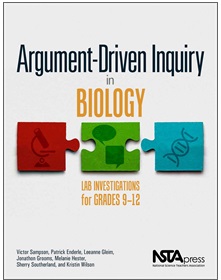Are Your Lab Investigations Argument Driven?
By Carole Hayward
Posted on 2014-07-21
 The 27 lab investigations in the new NSTA Press book Argument-Driven Inquiry in Biology: Lab Investigations for Grades 9-12 follow the argument-driven inquiry (ADI) instruction model, which consists of eight stages. These stages are designed to ensure that students have an opportunity to engage in the practices of science during a laboratory investigation and receive the feedback and explicit guidance that they need to improve on each aspect of science proficiency over the course of a school year.
The 27 lab investigations in the new NSTA Press book Argument-Driven Inquiry in Biology: Lab Investigations for Grades 9-12 follow the argument-driven inquiry (ADI) instruction model, which consists of eight stages. These stages are designed to ensure that students have an opportunity to engage in the practices of science during a laboratory investigation and receive the feedback and explicit guidance that they need to improve on each aspect of science proficiency over the course of a school year.
Authors Victor Sampson, Patrick Enderle, Leeanne Gleim, Jonathon Grooms, Melanie Hester, Sherry Southerland, and Kristin Wilson outline the eight ADI stages as follows:
Stage 1: Identification of the Task and the Guiding Question; “Tool Talk”
The goal of the teacher at this stage of the model is to capture the students’ interest and provide them with a reason to design and carry out an investigation.
Stage 2: Designing a Method and Collecting Data
The overall intent of this stage is to provide students with an opportunity to interact directly with the natural world using appropriate tools and data collection techniques and to learn how to deal with the ambiguities of empirical work.
Stage 3: Data Analysis and Development of a Tentative Argument
This stage calls for students to develop a tentative argument in response to the guiding question. Each group needs to be encouraged to first “makes sense” of the measurements they collected and the observations they made during stage 2.
Stage 4: Argumentation Session
Each group is given an opportunity to share, evaluate, and revise their tentative arguments with the other groups; scientific argumentation is an important practice in science and critique leads to better outcomes.
Stage 5: Explicit and Reflective Discussion
This stage of the model provides a context for teachers to explain the nature of scientific knowledge and how this knowledge develops over time. Students develop an appropriate understanding of the nature of science and scientific inquiry when teachers discuss these concepts in an explicit fashion.
Stage 6: Writing the Investigation Report
Each student is required to write an investigation report using his or her group’s argument that was developed and then evaluated by his or her classmates during the argumentation session.
Stage 7: Double-Blind Peer Review
Each student is required to submit to the teacher three typed copies of his or her investigation report. Reviewing each report as a group is an important component of the peer-review process because it provides students with a forum to discuss “what counts” as high quality or acceptable and in doing so forces them to reach a consensus during the process.
Stage 8: Revision and Submission of the Investigation Report
Once the peer-review process is complete, the final stage is to revise the report based on the suggestions given during the peer review. Once the report is revised, it is turned in to the teacher for evaluation with the original rough draft and the peer-review guide attached.
The 27 lab investigations included in the book are divided into these life science core ideas:
- From Molecules to Organisms: Structures and Processes
- Ecosystems: Interactions, Energy, and Dynamics
- Heredity: Inheritance and Variation of Traits
- Biological Evolution: Unity and Diversity
Each lab investigation includes notes for the teacher, student handouts, additional information for students, and checkout questions. Explore this free lab: Explanations for Animal Behavior: Why Do Great White Sharks Travel Over Long Distances?
The ADI instructional model was designed as a way to make lab activities more authentic and educative for students and thus help teachers promote and support the development of science proficiency inside the classroom. This model reflects research about how people learn science and is also based on what is known about how to engage students in argumentation and other important scientific practices.
This book is also available as an e-book.
Disclaimer: The views expressed in this blog post are those of the author(s) and do not necessarily reflect the official position of the National Science Teaching Association (NSTA).

